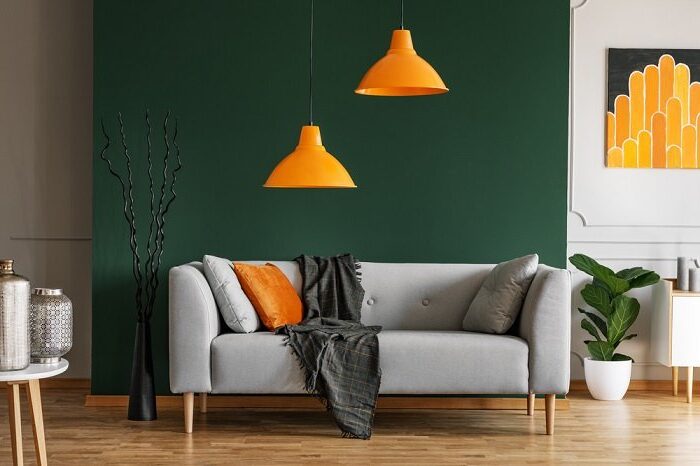Interior design is more than just decorating—it’s about creating a space that is both visually appealing and highly functional. Whether you’re styling a new home or revamping an existing space, understanding the essential principles of interior design will help you achieve a well-balanced and cohesive look. This guide covers the fundamental concepts of interior design, including color theory, furniture arrangement, lighting, and styling techniques to enhance your home.
The Key Principles of Interior Design
Interior design follows a set of foundational principles that ensure harmony and functionality in any space. The most important ones include:
1. Balance
Balance is achieved by distributing visual weight evenly throughout a room. There are three types of balance:
- Symmetrical Balance: Matching elements on both sides of a central focal point (e.g., identical bedside tables on either side of a bed).
- Asymmetrical Balance: A mix of different elements that have equal visual weight without being identical.
- Radial Balance: Arranging objects around a central feature, such as a chandelier or round dining table.
2. Harmony and Unity
A cohesive space is created when all elements work together seamlessly. This can be achieved through:
- A consistent color palette
- Repeating patterns and materials
- Coordinating furniture and decor across different rooms
3. Proportion and Scale
Proper proportion ensures that furniture and decor fit harmoniously within a space, while scale refers to how objects relate to each other.
- Avoid placing oversized furniture in small rooms to prevent a cramped feel.
- Mix objects of varying heights to create visual depth.
- Ensure large furniture pieces are complemented with appropriately sized accessories.
4. Rhythm and Repetition
Repetition of colors, patterns, and shapes creates a sense of flow within a space. This can be achieved by:
- Using a repeating color scheme throughout different rooms.
- Incorporating consistent furniture styles and materials.
- Layering patterns in rugs, cushions, and curtains for added texture.
5. Focal Point
A focal point draws the eye and anchors a room’s design. Common focal points include:
- A statement wall with bold wallpaper or paint.
- A large piece of artwork or a stylish mirror.
- A dramatic fireplace or furniture arrangement.
Color Theory in Interior Design
Color plays a significant role in shaping the ambiance of a room. Understanding basic color theory helps in selecting harmonious palettes:
- Neutral Colors (White, Beige, Gray): Create a timeless and sophisticated look.
- Warm Colors (Red, Orange, Yellow): Evoke energy and warmth, ideal for social spaces.
- Cool Colors (Blue, Green, Purple): Promote relaxation and calm, perfect for bedrooms and offices.
Popular Color Schemes:
| Color Scheme | Description | Best For |
|---|---|---|
| Monochromatic | Uses different shades of one color | Minimalist and modern interiors |
| Analogous | Combines colors next to each other on the color wheel (e.g., blue and green) | Nature-inspired and soothing spaces |
| Complementary | Uses contrasting colors (e.g., blue and orange) | High-contrast and dynamic rooms |
Furniture Arrangement Basics
Strategic furniture placement enhances both function and aesthetics. Here are some essential guidelines:
- Prioritize Functionality: Arrange furniture according to how the space will be used.
- Create Flow: Leave adequate space for movement between furniture pieces.
- Define Zones: Use rugs, lighting, and seating arrangements to separate different areas within an open-plan space.
- Highlight a Focal Point: Position furniture to draw attention to key design elements, such as a fireplace, TV, or large window.
Common Living Room Layouts
✅ Symmetrical Layout: Balanced furniture placement centered around a focal point.
✅ Open Concept Layout: Uses furniture and decor to create distinct zones in an open space.
✅ Casual Layout: Features modular or angled seating for a relaxed, inviting feel.
The Role of Lighting in Interior Design
Lighting is essential in setting the mood and functionality of a space. A well-designed lighting plan includes:
- Ambient Lighting: Overall room illumination through ceiling lights or recessed lighting.
- Task Lighting: Focused lighting for reading, working, or cooking (e.g., desk lamps, pendant lights).
- Accent Lighting: Highlights architectural details, artwork, or decorative pieces.
Tips for Effective Lighting Design
💡 Use dimmable lights to adjust ambiance based on time of day.
💡 Incorporate layered lighting to enhance depth and warmth.
💡 Position mirrors strategically to reflect light and create a brighter space.
Styling and Accessorizing
Once the foundational design elements are in place, accessories bring personality to a space.
Must-Have Decorative Elements
- Throw Pillows & Blankets: Add pops of color and texture.
- Artwork & Wall Decor: Choose pieces that reflect personal style.
- Indoor Plants & Greenery: Introduce a natural element for freshness.
- Rugs & Textiles: Define areas and add warmth to the design.
Quick Styling Tips
✅ Less is More: Avoid overcrowding with excessive decor.
✅ Mix Materials: Combine wood, metal, and fabrics for a layered look.
✅ Group Items in Odd Numbers: Arranging decor in sets of three or five creates balance.
Common Interior Design Mistakes to Avoid
🚫 Overcrowding the Space: Too much furniture makes a room feel cluttered.
🚫 Ignoring Scale and Proportion: Ensure furniture and decor fit the room’s dimensions.
🚫 Insufficient Lighting: A poorly lit room can feel unwelcoming and flat.
🚫 Matching Everything: Instead of using identical furniture sets, mix complementary pieces for variety.
Final Thoughts
Mastering the basics of interior design allows you to create a home that is both beautiful and functional. By applying key design principles, selecting a cohesive color scheme, arranging furniture thoughtfully, and incorporating well-chosen accessories, you can transform any space into a stylish and inviting sanctuary.
Start small, experiment with textures and colors, and let your creativity guide you. Whether you’re decorating a single room or designing an entire home, these interior design basics will help you achieve a space that reflects your personality and enhances your everyday life.
Ready to elevate your home’s interior? Begin with these foundational principles and watch your space come to life!
